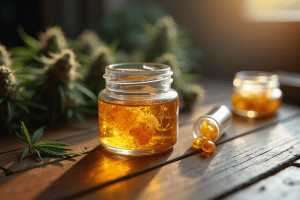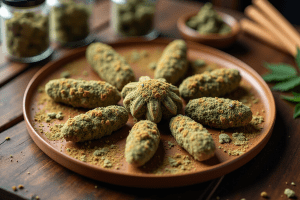Overview
Have you ever wondered about the term “spliff”? It refers to a rolled cigarette that combines marijuana with other plant materials, often tobacco. This combination not only alters the flavor but also affects the experience. In many Caribbean societies, spliffs hold cultural significance that reflects broader social practices and health implications.
Understanding the risks associated with mixing marijuana and tobacco is vital. By being aware, we can make informed choices that prioritize our well-being. Together, we can navigate these discussions and explore the implications of our choices. What are your thoughts on this blend of cultures and health? Let’s engage in this conversation and support each other in making the best decisions.
Introduction
In the evolving landscape of cannabis consumption, spliffs emerge as a fascinating blend of tradition and modernity, bringing together the worlds of cannabis and tobacco in a single roll. Have you ever wondered about the unique experience they offer? Often mistaken for joints, spliffs resonate deeply with cultural practices, especially within Caribbean communities, where they symbolize social connection and shared rituals. However, it’s important to consider that this fusion has its own health implications. The combination of nicotine and cannabis can alter effects and may heighten mental health risks.
As more users explore the intricate balance of flavors and effects, understanding the composition, cultural significance, and health considerations of spliffs becomes essential for informed consumption. Together, we can delve into the fundamentals of spliffs, their historical context, and how they compare to other smoking methods. This journey provides a comprehensive overview for both seasoned users and newcomers alike, empowering us to make choices that resonate with our well-being.
Define Spliff: Understanding the Basics
A joint is a rolled cigarette that combines marijuana and herb, typically wrapped in rolling paper. While the term ‘joint’ is often used interchangeably, the meaning of ‘spliff’ specifically refers to the inclusion of additional plant material in the mix. The ratio of marijuana to nicotine can vary, with a common blend being about 50% marijuana and 50% nicotine. This combination not only alters the flavor but can also impact the overall effects of marijuana, as the nicotine may enhance the experience for some users.
The term ‘spliff’ is believed to have originated from Jamaican Patois, where it denoted a marijuana cigarette, often without the addition of tobacco. Recent studies reveal that around 30% of marijuana users mix another plant product with marijuana in their spliffs. This practice raises important health concerns, as research indicates that using marijuana alongside tobacco can lead to increased anxiety and depression compared to those who exclusively use marijuana. For instance, a study assessing mental health symptoms among different user groups found that individuals combining marijuana and tobacco reported more significant mental health challenges, with a depression score of 7.58 (SE 0.40) for those using both substances.
Samantha Goodman from the School of Public Health at the University of Waterloo emphasizes the importance of acknowledging these risks. She notes that there is an urgent need for prevention and intervention initiatives targeting both marijuana and tobacco/nicotine use. Understanding the implications of joint usage is crucial for new marijuana consumers, as it highlights the potential health risks associated with this method of consumption. As the marijuana landscape evolves, being informed about the effects of mixing substances is essential for making responsible choices. Together, we can navigate these complexities and prioritize our well-being.
Explore the Cultural and Historical Context of Spliffs
In Caribbean culture, particularly in Jamaica, the meaning of spliff is deeply rooted in Rastafarian beliefs and reggae music. Have you ever considered how traditions shape our social experiences? For many, joints are a favored way to enjoy marijuana, especially in social settings. The practice of mixing tobacco with marijuana—often associated with spliff—extends beyond Jamaica, finding acceptance in several European nations as well. This preference highlights social norms that view the mixture as a way to enhance the smoking experience, connecting directly to the essence of spliff.
In Caribbean societies, spliff is linked to relaxation and camaraderie, often shared among friends during gatherings. According to a study from the University of the West Indies, Mona, a significant 51 percent of herb users engage with cannabis for medical, recreational, and sacramental purposes simultaneously. This finding underscores the multifaceted role of cannabis in Jamaican life. It’s important to recognize that the meaning of spliff transcends mere usage; it symbolizes a communal bond and a shared practice that enriches social interactions.
Understanding the historical context of cannabis use is crucial, as it reflects broader societal behaviors, including trends in marijuana use among adolescents. Research reveals that adolescents who engage in sexual activity before the age of 14 are about twice as likely to have used marijuana recently compared to those who begin later. This insight emphasizes the need for comprehensive interventions focused on emotional wellbeing and substance use education, particularly in relation to the cultural practices surrounding joints.
Ultimately, rolled cigarettes are more than just a means of consumption; appreciating the meaning of spliff reveals their integral role in the social fabric of Caribbean communities. Together, let’s foster a deeper understanding of these cultural practices and their implications for our well-being.
Analyze the Composition: What Goes into a Spliff?
A common joint is crafted from ground marijuana and loose leaf, lovingly wrapped together in a thin paper. The selection of marijuana variety plays a vital role in shaping both the taste and strength of the joint, while the type of smokeable leaf can significantly enhance the overall inhalation experience. Many users choose to elevate their joints by opting for flavored rolling papers or incorporating additional herbs, enriching the taste profile.
The ratio of marijuana to other herbs in a joint can vary widely. Some users may prefer a higher marijuana content for a more intense effect, while others might seek a balanced blend for a smoother smoke. Research indicates that the typical proportion of marijuana in rolled joints can differ greatly, reflecting personal choices and desired outcomes. Notably, studies have shown that the amount of tobacco in joints during the CAN+TOB condition ranged from 0.00 to 0.59 grams, highlighting the variability in tobacco content in rolled cigarettes. This flexibility allows users to customize their joint to align with their unique preferences and effects, making it a versatile option in marijuana consumption.
Moreover, understanding the various marijuana strains available at dispensaries—Indica, Sativa, and Hybrid—can further enhance your joint composition. Indica strains are recognized for their relaxing effects, making them perfect for unwinding, while Sativa strains provide uplifting sensations that can enhance social experiences. Hybrid strains offer a balance, catering to diverse preferences. Additionally, studies have revealed that the meaning of a spliff can differ based on user preferences for tobacco types, with some favoring traditional tobacco while others explore alternatives. Recognizing these preferences is crucial, as it informs broader discussions about marijuana use and its implications for health and policy.
As Chandni Hindocha noted, “Understanding how much marijuana is in a joint will inform important drug policy discussions and enhance research outcomes when estimating dose.” This underscores the significance of understanding joint composition in the evolving cannabis landscape. The exploration of cannabis composition remains an important topic for both consumers and researchers alike.
Compare Spliffs with Joints and Blunts: Key Differences
The primary distinction among spliffs, joints, and blunts lies in their composition and the unique experiences they offer. A joint, a rolled marijuana cigarette containing solely marijuana, provides a more refined method of consumption that many appreciate. In contrast, a blunt is typically wrapped in a thicker leaf, often a cigar wrap, and also contains only marijuana. A decent blunt can last about 20 minutes or more, offering a prolonged smoking experience that some users find appealing. The spliff, however, introduces a unique combination of herbs with nicotine, creating a smoking experience that brings together the stimulating effects of nicotine alongside the herbal properties of marijuana. This combination can significantly change the overall experience, attracting those who enjoy the invigorating effects of nicotine.
As we look ahead to 2025, we observe a significant trend in consumer preferences: while joints remain popular for their pure marijuana experience, rolled cigarettes are increasingly favored in cultures where tobacco is traditionally blended with marijuana. This preference often stems from the unique flavor profile and smoking sensation that these rolled products provide. Interestingly, many blunt smokers may not recognize their usage as marijuana use, suggesting a potential disconnect in how smoking blunts is perceived compared to traditional marijuana consumption. How does this perception influence your views on marijuana use?
Research into the health effects of mixed substances versus pure marijuana reveals differing impacts, particularly regarding additives. While some users cherish the enhanced experience of rolled joints, health experts caution against the risks associated with tobacco use. A recent study highlighted that 65 percent of women who use marijuana feel that those around them remain unaware of their usage. This statistic opens up a wider discussion about marijuana use and its social implications, especially concerning spliffs and blunts. What are your thoughts on this?
Ultimately, the decision surrounding spliff meaning, as well as joints and blunts, is shaped by personal preference, cultural traditions, and health factors. Understanding these distinctions can empower us to make informed choices about our consumption methods. Additionally, as the cannabis industry continues to evolve—evidenced by tax revenue trends where 10 states generated more tax revenue from marijuana than from alcohol in early 2023—the significance of these consumption methods becomes increasingly relevant. Together, let’s navigate these choices with care and consideration.
Conclusion
The exploration of spliffs highlights their unique role in both cultural and consumption contexts. As a blend of cannabis and tobacco, spliffs provide a distinct experience that resonates deeply within Caribbean traditions, symbolizing social connection and shared rituals. By understanding the historical significance and social nuances surrounding spliff usage, we can appreciate the multifaceted role of cannabis in these communities, where spliffs serve not only as a means of consumption but also as a medium for fostering camaraderie.
However, it’s essential to consider the health implications of combining tobacco with cannabis. Research indicates that this mixture can exacerbate mental health issues. Therefore, it’s crucial for users to be aware of the potential risks associated with spliff consumption. The varying compositions of spliffs, influenced by individual preferences for cannabis strains and tobacco types, further complicate the conversation around their effects and benefits.
When we compare spliffs to joints and blunts, we see that spliffs offer a unique smoking experience catering to specific cultural practices and personal tastes. While some may prefer the purity of joints or the prolonged experience of blunts, the choice ultimately lies in individual preference and cultural background. As the cannabis landscape evolves, understanding the implications of these different consumption methods becomes essential for making informed choices that prioritize our well-being. This knowledge empowers us to navigate the intricate balance between enjoyment and health, ensuring that our cannabis journey aligns with our values and lifestyle. Together, let’s explore these choices mindfully, fostering a community that values both enjoyment and health.
Frequently Asked Questions
What is a joint and how is it different from a spliff?
A joint is a rolled cigarette that combines marijuana and herb, typically wrapped in rolling paper. A spliff specifically refers to a joint that includes additional plant material, often tobacco, in the mix.
What is the common ratio of marijuana to nicotine in a spliff?
A common blend in a spliff is about 50% marijuana and 50% nicotine.
How does mixing nicotine with marijuana affect users?
The combination of nicotine and marijuana can alter the flavor and may impact the overall effects of marijuana, with some users reporting an enhanced experience.
What is the origin of the term “spliff”?
The term “spliff” is believed to have originated from Jamaican Patois, where it referred to a marijuana cigarette, often without the addition of tobacco.
What percentage of marijuana users mix another plant product with marijuana in their spliffs?
Recent studies reveal that around 30% of marijuana users mix another plant product, such as tobacco, with marijuana in their spliffs.
What are the health concerns associated with mixing marijuana and tobacco?
Research indicates that using marijuana alongside tobacco can lead to increased anxiety and depression compared to those who exclusively use marijuana.
What did a study find regarding mental health symptoms among users of marijuana and tobacco?
A study found that individuals combining marijuana and tobacco reported more significant mental health challenges, with a depression score of 7.58 for those using both substances.
Why is it important to understand the implications of joint usage?
Understanding the implications of joint usage is crucial for new marijuana consumers as it highlights the potential health risks associated with mixing substances, emphasizing the need for informed choices.
Get Your Medical Card
Connect with a licensed physician online in minutes












